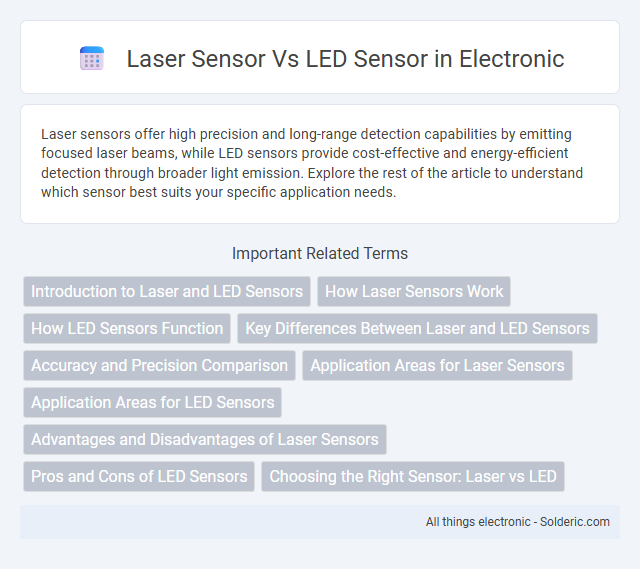Laser sensors offer high precision and long-range detection capabilities by emitting focused laser beams, while LED sensors provide cost-effective and energy-efficient detection through broader light emission. Explore the rest of the article to understand which sensor best suits your specific application needs.
Comparison Table
| Feature | Laser Sensor | LED Sensor |
|---|---|---|
| Light Source | Coherent laser beam | Incoherent LED light |
| Accuracy | High precision, up to micrometers | Moderate precision |
| Range | Long range detection (up to several meters) | Short to medium range |
| Power Consumption | Higher power usage | Lower power consumption |
| Cost | More expensive | Cost-effective |
| Response Time | Faster response | Slower response |
| Applications | Precision measurements, distance sensing, industrial automation | Proximity detection, object counting, basic presence sensing |
| Environmental Sensitivity | Sensitive to dust and ambient light interference | Less affected but limited by ambient light |
Introduction to Laser and LED Sensors
Laser sensors emit coherent, focused light beams that provide precise distance measurements and high accuracy, making them ideal for applications requiring fine resolution. LED sensors utilize incoherent, broad-spectrum light, offering lower cost and simpler design but with reduced range and sensitivity compared to laser sensors. Both sensor types serve in object detection and industrial automation, with laser sensors excelling in detailed scanning and LED sensors preferred for general presence detection.
How Laser Sensors Work
Laser sensors operate by emitting a focused laser beam that reflects off a target object, with a detector measuring the time it takes for the light to return, enabling precise distance calculation through time-of-flight principles. These sensors offer high accuracy and long-range detection by utilizing coherent light, which reduces scattering and improves signal clarity compared to LED sensors. The laser's narrow beam allows for detailed object profiling and precise measurement in industrial automation, robotics, and quality control applications.
How LED Sensors Function
LED sensors operate by emitting light from a light-emitting diode and detecting the reflected light from a target object to measure distance or presence. The sensor's photodetector captures the intensity or timing of the reflected light, enabling accurate detection in various applications. Compared to laser sensors, LED sensors typically offer lower cost and simpler design but may have reduced precision and range.
Key Differences Between Laser and LED Sensors
Laser sensors provide highly precise distance measurements with narrow beam divergence suitable for long-range and fine detection, while LED sensors emit a broader light spectrum ideal for short-range sensing and general presence detection. Laser sensors use coherent light resulting in faster response times and higher accuracy compared to the incoherent light from LEDs. Your choice depends on required measurement precision, range, and environmental conditions where the sensor will operate.
Accuracy and Precision Comparison
Laser sensors offer higher accuracy and precision than LED sensors due to their coherent light source, which produces a narrow and focused beam, enabling precise distance measurements with minimal scatter. LED sensors, relying on incoherent light, have broader beams that result in less accurate readings and greater susceptibility to environmental interference. Applications demanding sub-millimeter precision favor laser sensors for reliable and consistent measurements.
Application Areas for Laser Sensors
Laser sensors excel in industrial automation, enabling precise distance measurement, object detection, and positioning in manufacturing and robotics. They are widely used in automotive systems for collision avoidance and adaptive cruise control, as well as in logistics for barcode scanning and inventory management. Their high accuracy and fast response time make them ideal for quality control, level measurement, and hazardous environment monitoring.
Application Areas for LED Sensors
LED sensors excel in applications requiring non-contact measurement of distance, position, or color detection in industries like packaging, automation, and consumer electronics. Their affordability, durability, and resistance to interference make them ideal for use in manufacturing lines, object detection, and environmental sensing. Your choice of LED sensors supports efficient, reliable data capture in diverse environments where precision and cost-effectiveness are critical.
Advantages and Disadvantages of Laser Sensors
Laser sensors provide high precision and long detection range, making them ideal for applications requiring accurate distance measurement and object detection in industrial automation. Their disadvantages include sensitivity to environmental conditions such as dust, fog, or smoke, and higher cost compared to LED sensors. Unlike LED sensors, laser sensors consume more power and may require more maintenance due to their complex optical components.
Pros and Cons of LED Sensors
LED sensors offer cost-effective operation and longer lifespan compared to laser sensors, making them suitable for basic proximity and ambient light detection applications. Their lower precision and shorter detection range limit their use in high-accuracy or long-distance measurements, areas where laser sensors excel due to focused beams and higher resolution. LED sensors are less sensitive to interference but can struggle in environments with varying light conditions, reducing reliability in certain industrial or outdoor settings.
Choosing the Right Sensor: Laser vs LED
Laser sensors offer higher precision and longer detection ranges, making them ideal for applications requiring accurate distance measurement and fast response times. LED sensors provide cost-effective, reliable performance with lower power consumption and are suitable for short-range object detection and basic sensing tasks. Understanding your specific needs for accuracy, range, and budget will help you choose the right sensor for your application.
laser sensor vs LED sensor Infographic

 solderic.com
solderic.com